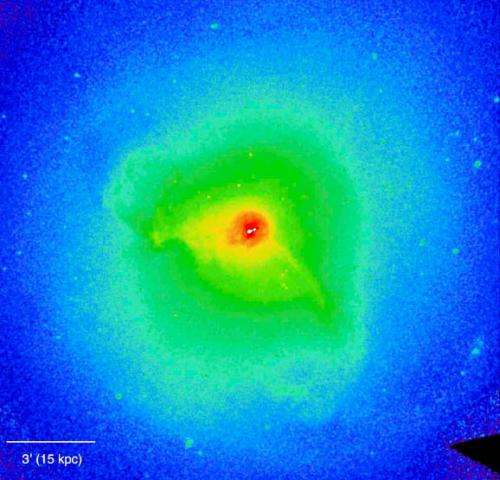Staying warm: The hot gas in clusters of galaxies

Most galaxies lie in clusters, groupings of a few to many thousands of galaxies. Our Milky Way galaxy itself is a member of the "Local Group," a band of about fifty galaxies whose other large member is the Andromeda Galaxy about 2.3 million light-years away. The closest large cluster of galaxies to us is the Virgo Cluster, about 50 million light-years away, with about 2000 members.
The space between the galaxies in clusters is filled with very hot gas – its temperature is of order ten million kelvin, or even higher. Most of the matter in the so-called intracluster medium is in the form of this very hot gas. Hot gas should cool off, and one of the major puzzles about galaxy clusters is that the hot intracluster gas does not seem to cool. In fact, calculations based on the energy radiated indicate that the gas should cool about ten times faster than is observed. X-ray observations of the hot gas also suggest that it might be turbulent, perhaps driven by mechanical flows of matter pouring outward from the supermassive black holes at the centers of the clusters' galaxies, perhaps creating inflating bubbles of fast-moving charged particles that stir and heat the gas. Unfortunately, current X-ray observatories do not have the ability to measure the supposed gas velocities to test this proposed solution.
A team of astronomers including CfA scientists Bill Forman and Alexey Vikhlinin have pioneered a new method to evaluate the turbulence of the hot intracluster gas. They took advantage of the superb spatial resolution and sensitive images from the Chandra X-Ray Observatory to probe small clumps distributed through two clusters, Perseus and Virgo. They analyze the structures as resulting from turbulence, and then inferred the turbulent velocities needed, deriving values up to about 145 kilometers per second. These velocities are indeed adequate to heat the gas over all the scales observed over the cluster, and could readily be produced by black hole jets. The results are very encouraging, though not definitive, and imply that no mysterious mechanisms needed to be invoked to explain the enduring hot gas.
More information: "Turbulent Heating in Galaxy Clusters Brightest in X-rays," I. Zhuravleva, E. Churazov, A. A. Schekochihin, S. W. Allen, P. Arévalo, A. C. Fabian, W. R. Forman, J. S. Sanders, A. Simionescu, R. Sunyaev, A. Vikhlinin, & N. Werner, Nature, 515, 85, 2014.
Journal information: Nature
Provided by Harvard-Smithsonian Center for Astrophysics





















